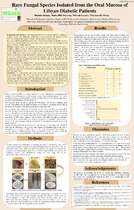Rare fungal species isolated from Libyan diabetic patients

View/
Date
2016Author
Esmaio, Mustafa
Abrantes, Pedro Miguel dos Santos
Africa, Charlene W.J.
Metadata
Show full item recordAbstract
BACKGROUND AND OBJECTIVES: The emerging resistance of Candida species to antifungals routinely used to treat candidiasis in HIV patients and in patients with diabetes mellitus (DM) has resulted in the frequent isolation of non-albicans Candida species.
This study aimed to establish the prevalence and fluconazole resistance profiles of yeasts other than commonly identified Candida species which may be found colonizing the oral mucosa of Libyan patients with DM.
METHODS: Fungal species were isolated from the oral cavity of DM-positive patients attending a diabetes clinic in Misrata Diabetes Centre in Libya. This study included patients aged between 35 and 95 years and excluded subjects who had been on antifungal therapy within two weeks prior to sample collection. The identification of the isolated species was done by growing the isolates on selective and chromogenic media and by API ID 32C biochemical testing. Antimicrobial susceptibility testing of the isolates to the antifungal fluconazole was performed using disk diffusion. The study complied with the Declaration of Helsinki (2013).
RESULTS: Forty-four rare fungal isolates representing ten fungal species were identified from the oral mucosa of 194 patients, with 28.6% of rare Candida species demonstrating resistance to fluconazole. Saprochaete capitata and Cryptococcus humicola isolates demonstrated high levels of resistance to fluconazole, with other yeast species showing lower resistance levels.
CONCLUSION: The methodologies used in this study allowed for the accurate identification of rare fungal species. The API 32 ID system was found to be a better identification method when compared to chromogenic media, as some species could not be identified with the latter. This study emphasizes the importance of accurate species identification and antifungal surveillance in patients with underlying chronic diseases such as DM who have higher morbidity and mortality rates due to less known and resistant fungal infections.
